Blog
November 14th, 2012
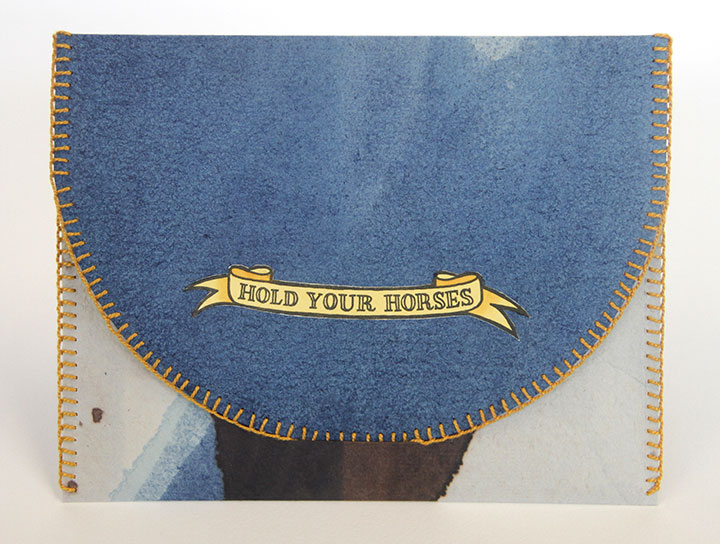
I’m pleased to present my latest artist book, Hold Your Horses.
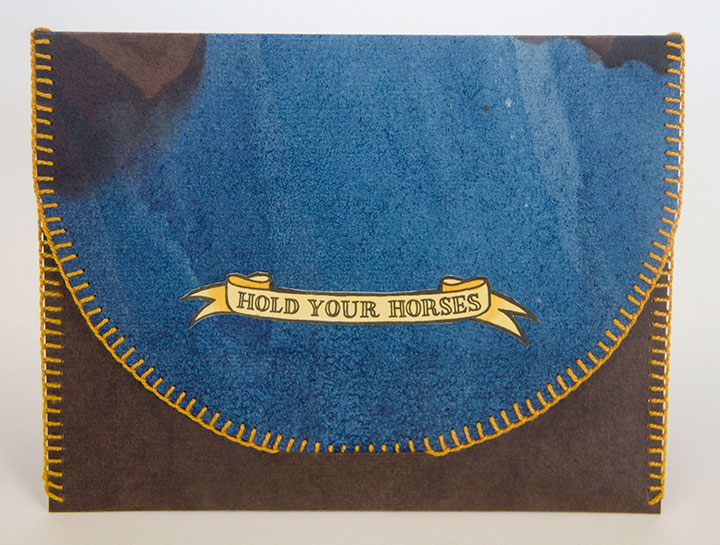
The book consists of a hand-bound portfolio (in various one-of-a-kind colors) that…well..holds some horses.
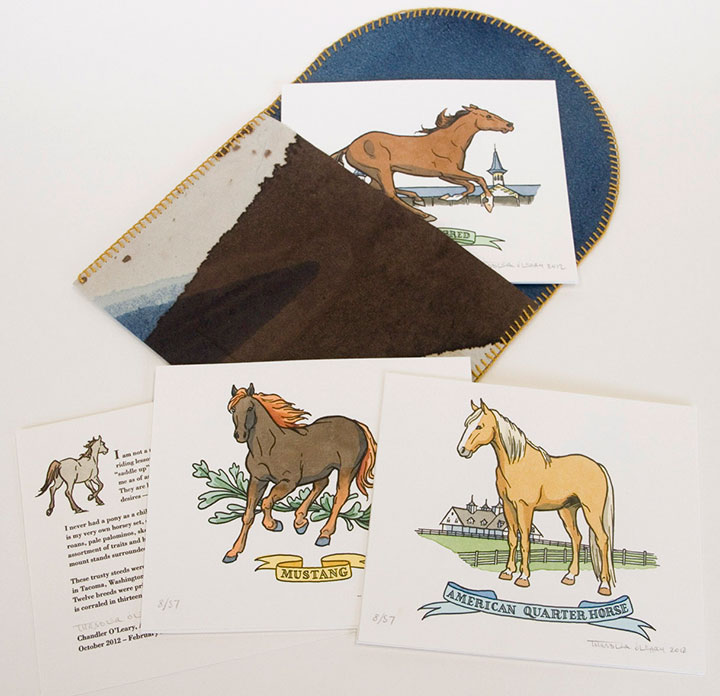
I figured it was only a matter of time before I did another print set like I did with the birds.

This time, though, I picked my favorite equine breeds,
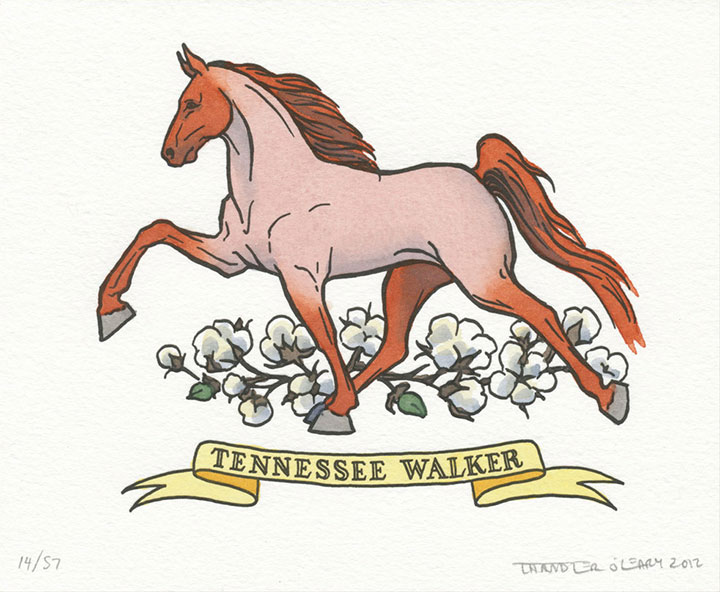
took the opportunity to push the envelope of what hand-coloring could do,
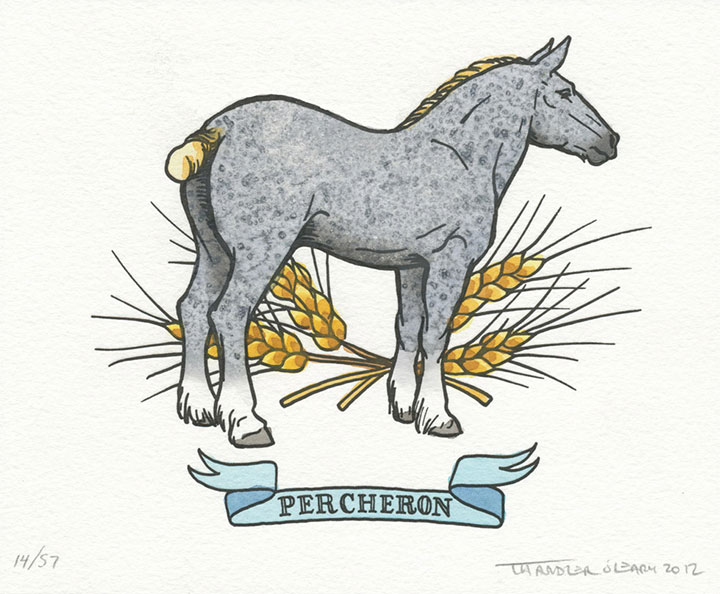
and even experimented with some wacky painting techniques.
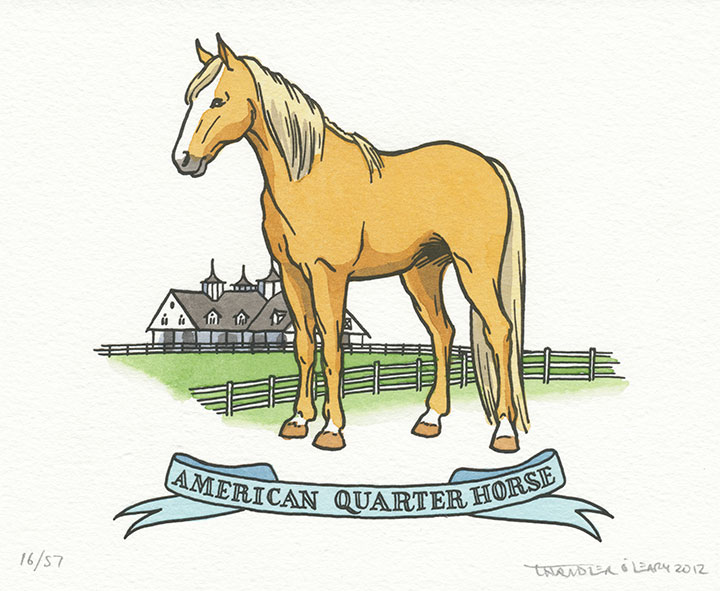
I’m really happy with how these turned out, and I can’t wait to show them off at Codex in February!
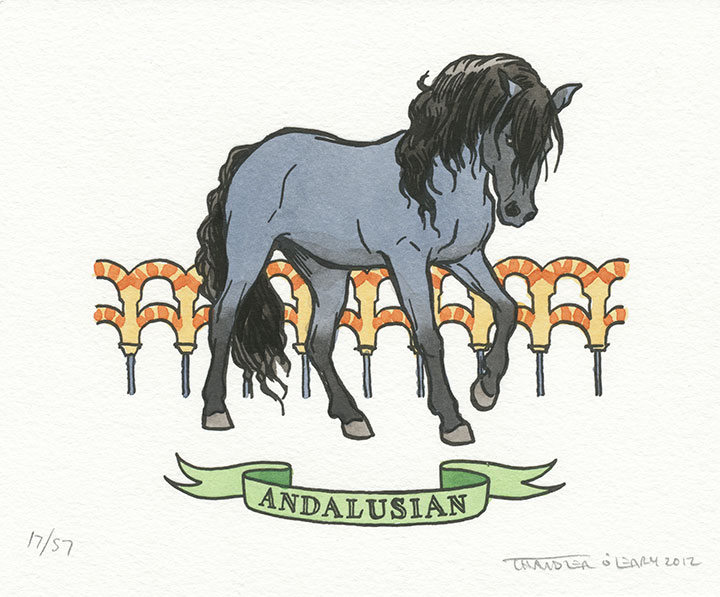
Colophon reads:
I am not a member of the horsey set. I grew up far too poor for riding lessons, and I can’t claim ever to have used the phrase “saddle up” in the literal sense. Yet horses are as much a part of me as of any American who ever looked westward in wonder. They are living symbols of the wildness that still infuses our deepest desires—even if they no longer permeate our everyday culture.
I never had a pony as a child, but now I can boast a round dozen. Enclosed here is my very own horsey set, displayed in an equine rainbow of dapple grays, strawberry roans, pale palominos, skewbald bays and rich chestnuts. This assembly gathers an assortment of traits and histories to tell the story of our fascination with horses. Each mount stands surrounded by the trappings of its trade or the symbols of its origins.
These trusty steeds were letterpress printed and individually hand-painted in Tacoma, Washington—at the very end of a frontier founded on horsepower. Twelve breeds were printed in an edition of 57 impressions apiece; the entire herd is corraled in thirteen saddle-bag sets.
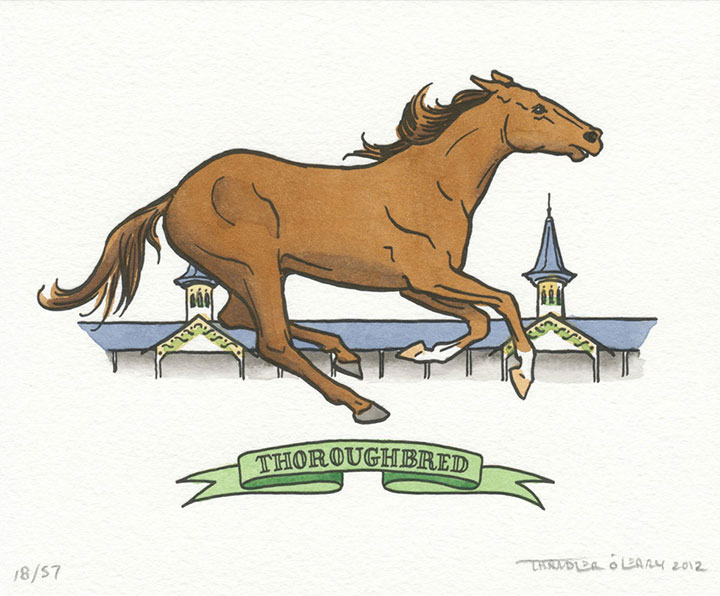
UPDATE (May 2014): a Hold Your Horses set is now part of the permanent collections at both the Phoenix Public Library and the University of Virginia Library! So if you’re local to either of those places, you can go check them out in person!
You’ll find individual horse prints in the shop.
Giddy up!

November 5th, 2012
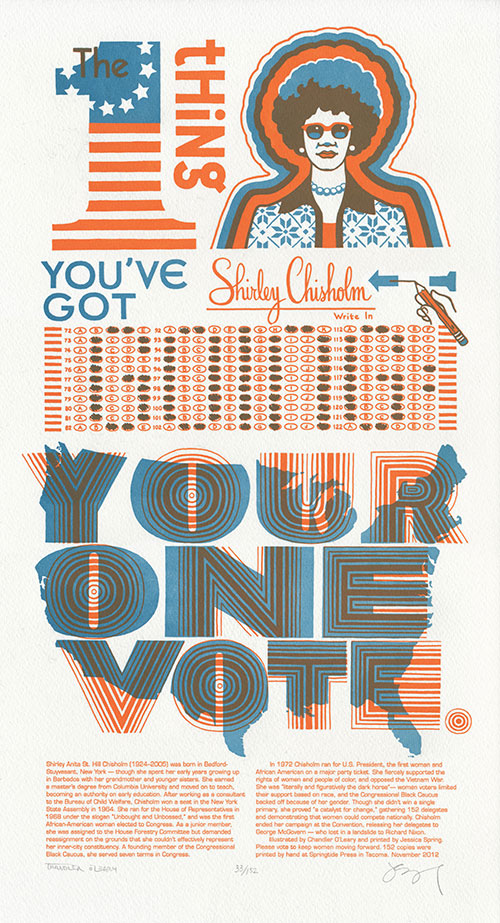
If you have any sort of link to the outside world (television, radio, internet access, newspaper, mailbox), chances are you’ve been unable to escape this year’s deluge of advertising, chatter and glossy-printed recycling fodder—all centered around this coming Tuesday. It’s enough to have even four-year-olds throwing up their hands in frustration. Jessica and I, however, have spent many hours sifting through election material—1972 election material, I mean. To remind us of what’s really important this year (and every year), we turned to the woman who help paved the way for our current President.
The one thing you’ve got going: your one vote. —Shirley Chisholm
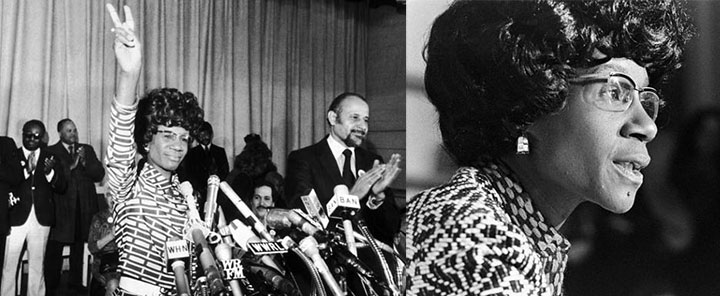
Shirley Chisholm was one of fifteen Presidential candidates in 1972. It was a volatile time: the Vietnam War was the center of public discord; movements for civil rights and gender equality were major issues around the western world; and the race came on the heels of the 1968 race—one of the bloodiest election years in American history.
Shirley knew she was a long shot; she even referred to herself as “literally and figuratively the dark horse.” Yet she also knew that to run for President, all that was required was to be a natural-born U.S. citizen of at least 35 years of age. There was nothing in there about being male or Caucasian—and as a member of the U.S. House of Representatives, she was at least as qualified as her fellow candidates. So she ran, because it was her right, and because she knew that if she played it smart and started winning delegates, she’d have some power to leverage.
Shirley sought to create a truly representative government. Rather than a cookie-cutter set of interchangeable politicians running the country, she envisioned an America where each region, economic sector and ethnic group elected one of its own to office. She wanted to see a woman heading the Department of Education & Welfare; a Native American in charge of the Department of the Interior. And as a freshman Congresswoman she was assigned to the House Forestry Committee but refused to serve—how would forest stewardship or agricultural bills represent New York’s inner-city 12th Congressional District?
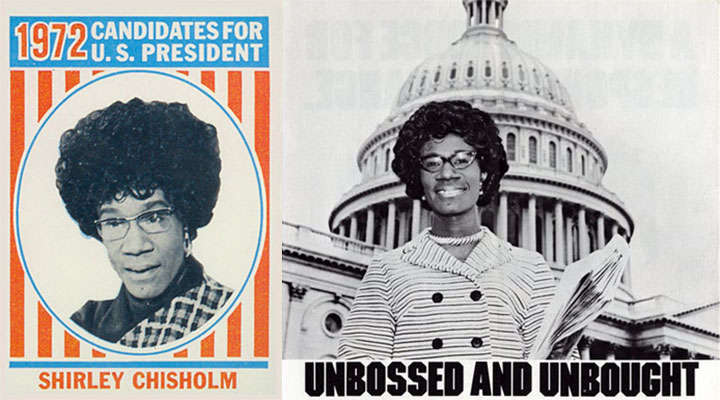
She also saw her office as an opportunity to encourage women—especially women of color—to get involved in politics. Every member of her staff was a woman, half of them African-American. To say the least, her very presence made her fellow legislators nervous—and on top of everything else, she was probably the only woman of color in the whole country who made the exact same salary as her white male colleagues. (Heck, for people like Yvette Clarke or Barbara Lee, that’s probably still true for the most part. How depressing is that?)
On the national political stage, however, her race and gender were two strikes against her. She gathered support from the National Organization for Women, but when the time came for NOW to officially endorse a candidate, their squeamishness over the possibility of a black nominee overcame their lip service. And the Black Congressional Caucus, of which Shirley was a founding member, threw her under a bus because they couldn’t bring themselves to support a female candidate. To me, that’s the most interesting thing—Shirley Chisholm always said she faced far more discrimination over her gender than the color of her skin.
Still, though she had to battle opposition and prejudice from all sides, she worked to bring people of all stripes together. When her opponent George Wallace (yes, that George Wallace—Mr. “Segregation Now, Segregation Tomorrow, Segregation Forever”) was wounded in an assassination attempt, Shirley visited him in the hospital. They were the ultimate Odd Couple: years later Wallace used his clout among Southern congressmen to help Shirley pass a bill giving domestic workers the right to a minimum wage.
In the end, though she gathered 152 delegates, she knew she’d never snag the Democratic nomination. So she conceded to George McGovern—who went on to win just one state (Massachusetts) in the 1972 Presidential election. Take a look at the electoral college map for that year:
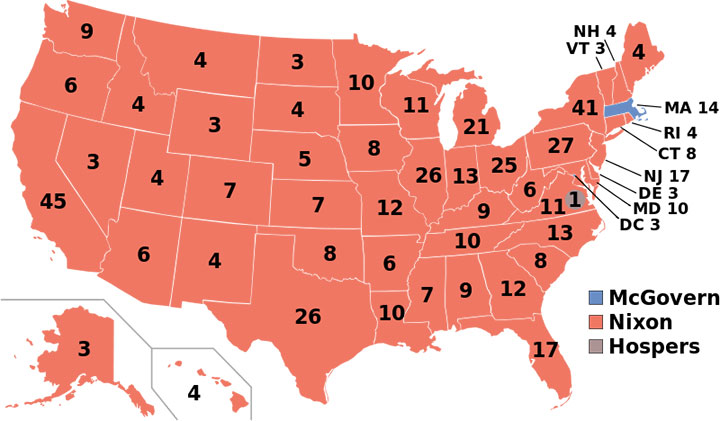
That’s a whole lotta red.
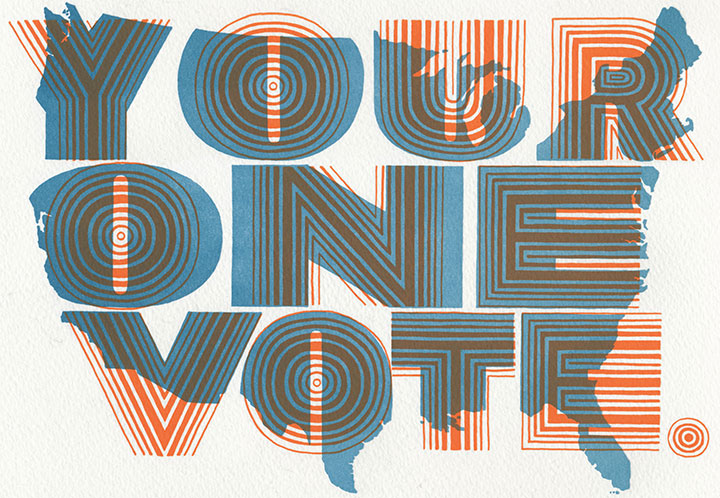
And since this election season marks the fourth anniversary of our series, that map was the starting point for Keep the Change, our new Dead Feminist broadside. I redrew the map in blue, and from there we crafted a period homage to Shirley’s impeccable style and substance.
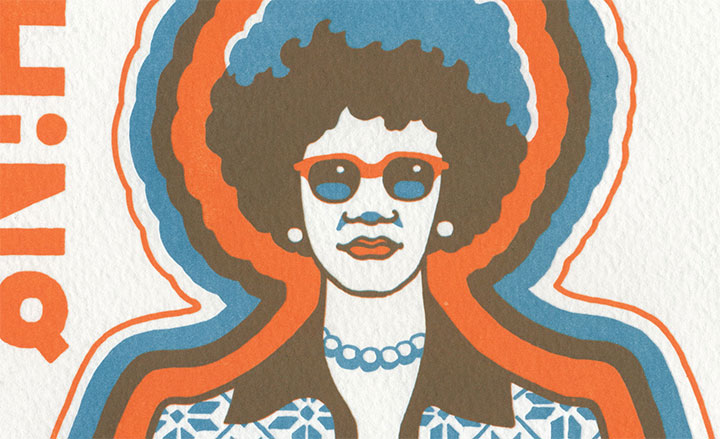
The 12th Congressional District was one of the areas hardest hit last week by Hurricane Sandy. While the immediate recovery efforts in the city are crucial, we also recognize the importance of serving a community long after the disaster relief efforts have ended. So to help continue Shirley’s long-term service to her home city, we’ll be donating a portion of our proceeds to Bedford Stuyvesant Restoration, the nation’s first non-profit community development corporation. Restoration partners with residents and businesses to improve the quality of life of Central Brooklyn by fostering economic self sufficiency, enhancing family stability, promoting the arts and culture and transforming the neighborhood into a safe, vibrant place to live and work.
In the meantime, let’s do what Shirley did best—cast our vote, and keep fighting the good fight.
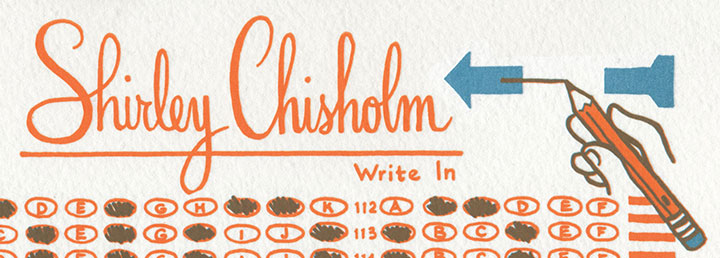
• • • • • • • • • • • • • • • • • • • • • • • • • • • • • • • • • • • • • • • • • • • • • • • • • • • • • • • • • • • •
Keep the Change: No. 16 in the Dead Feminists series
Edition size: 152
Poster size: 10 x 18 inches
Printed on an antique Vandercook Universal One press, on archival, 100% rag (cotton) paper. Each piece is numbered and signed by both artists.
Colophon reads:
Shirley Anita St. Hill Chisholm (1924–2005) was born in Bedford-Stuyvesant, New York — though she spent her early years growing up in Barbados with her grandmother and younger sisters. She earned a master’s degree from Columbia University and moved on to teach, becoming an authority on early education. After working as a consultant to the Bureau of Child Welfare, Chisholm won a seat in the New York State Assembly in 1964. She ran for the House of Representatives in 1968 under the slogan “Unbought and Unbossed,” and was the first African-American woman elected to Congress. As a junior member, she was assigned to the House Forestry Committee but demanded reassignment on the grounds that she couldn’t effectively represent her inner-city constituency. A founding member of the Congressional Black Caucus, she served seven terms in Congress.
In 1972 Chisholm ran for U.S. President, the first woman and African American on a major party ticket. She fiercely supported the rights of women and people of color, and opposed the Vietnam War. She was “literally and figuratively the dark horse”— women voters limited their support based on race, and the Congressional Black Caucus backed off because of her gender. Though she didn’t win a single primary, she proved “a catalyst for change,” gathering 152 delegates and demonstrating that women could compete nationally. Chisholm ended her campaign at the Convention, releasing her delegates to George McGovern — who lost in a landslide to Richard Nixon.
Illustrated by Chandler O’Leary and printed by Jessica Spring. Please vote to keep women moving forward.
Available now in the Dead Feminists shop!
October 12th, 2012
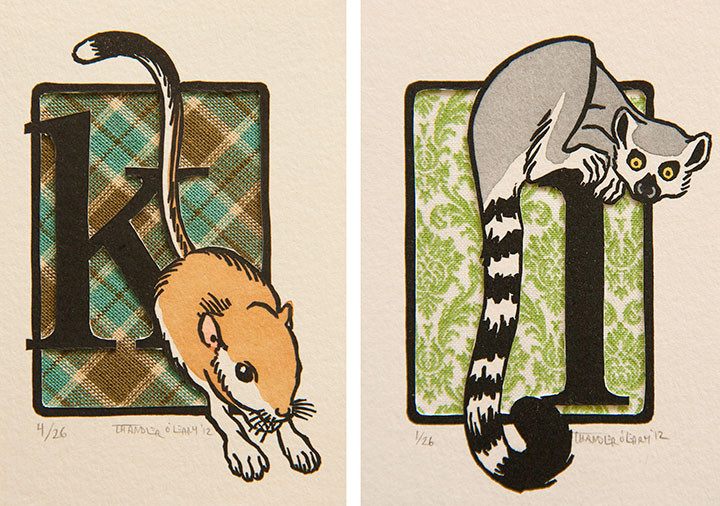
I’ve been asked to take part in another collaborative letterpress portfolio—this time, with the theme of an animal abecedary. Each of the participants gets just a couple of letters in the collection, and I’m happy to report I nabbed two of my favorites. For these prints I experimented with something a little different. They’re hand-painted linocuts, like I often make—but these are hand-cut to reveal a fabric background. I’m pretty happy with how these turned out—now to file away the idea for future use!
September 12th, 2012
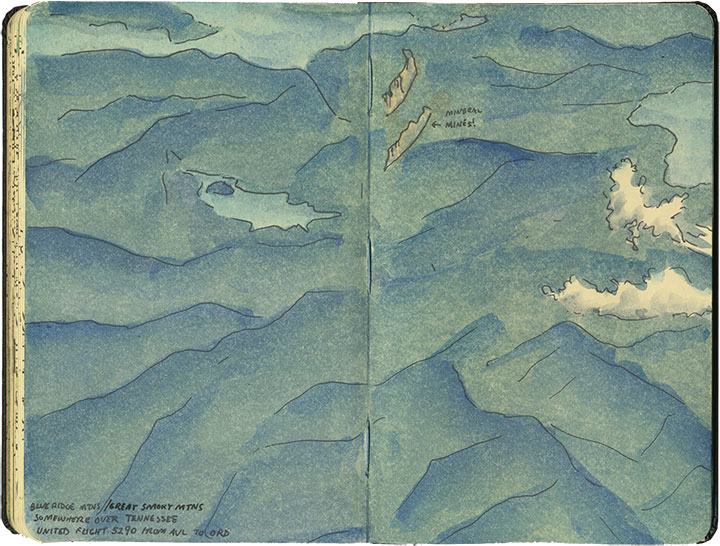
Since Jessica and I got back from teaching at the Penland School of Crafts, I’ve been struggling to put the experience into words. But no matter how I go on about how beautiful the Blue Ridge Mountains are; or how unique Penland’s creative culture is; or how amazingly talented each and every one of our students were; or how seriously delicious a hot bowl of cheese grits is after a walk in the chilly morning fog; or how many wonderful people we met; or how much we loved the challenge of basically teaching two classes in one intense week—well, I get a little incoherent. So I’ll let my sketchbook do the talking. (I kept a little notebook in my apron pocket all week, and every time I had a second to spare, I was scribbling away.)

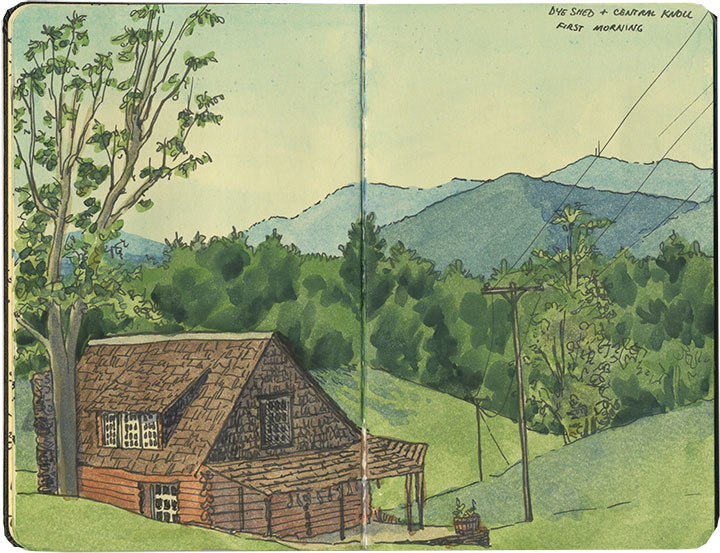
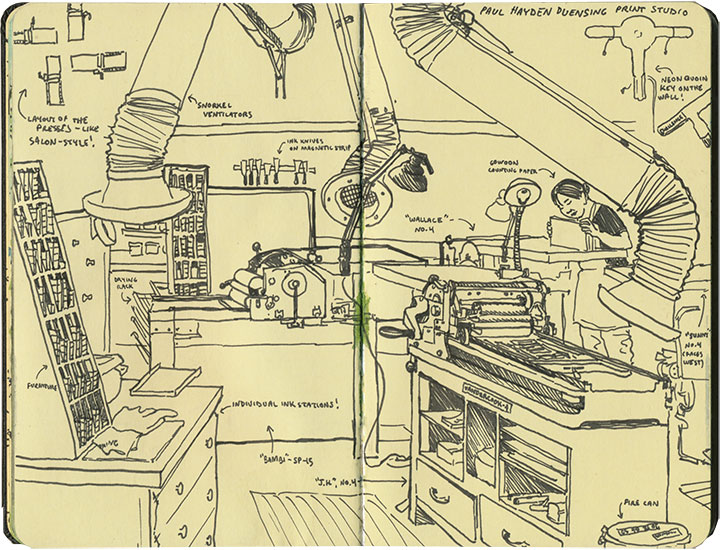
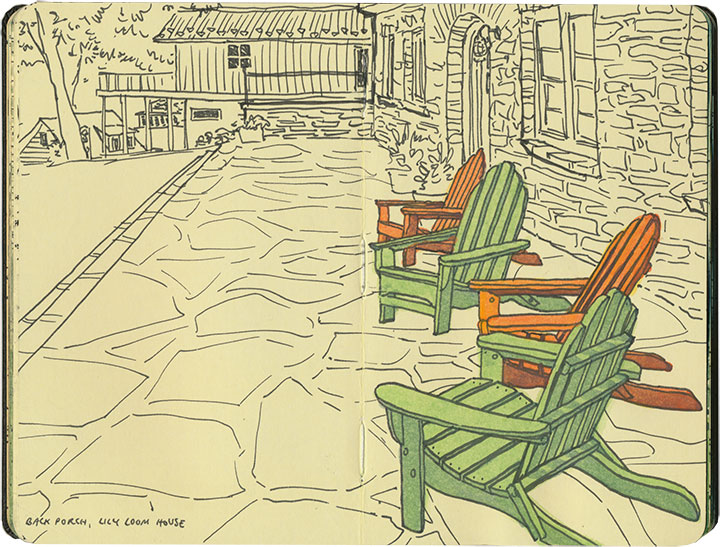
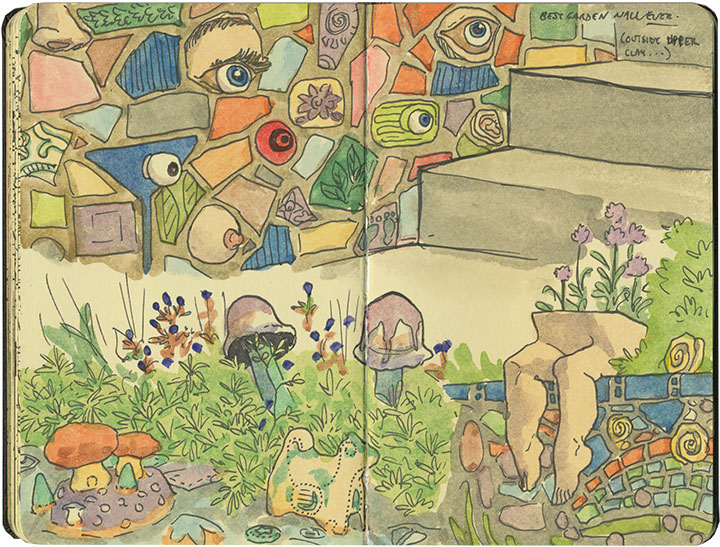
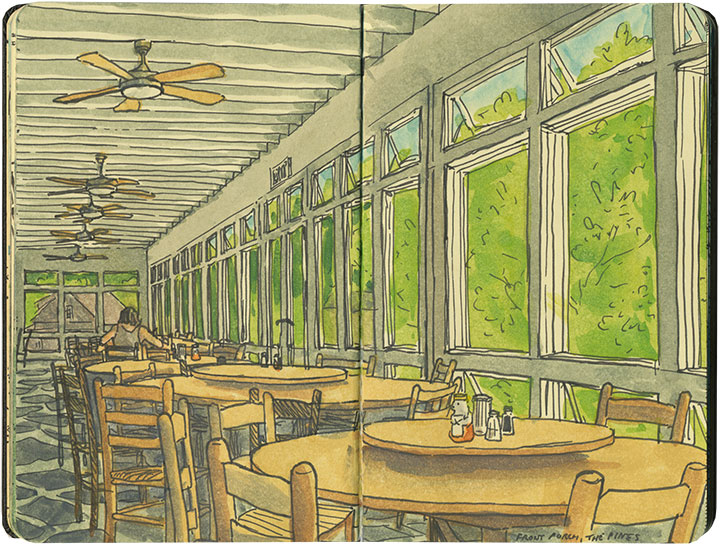
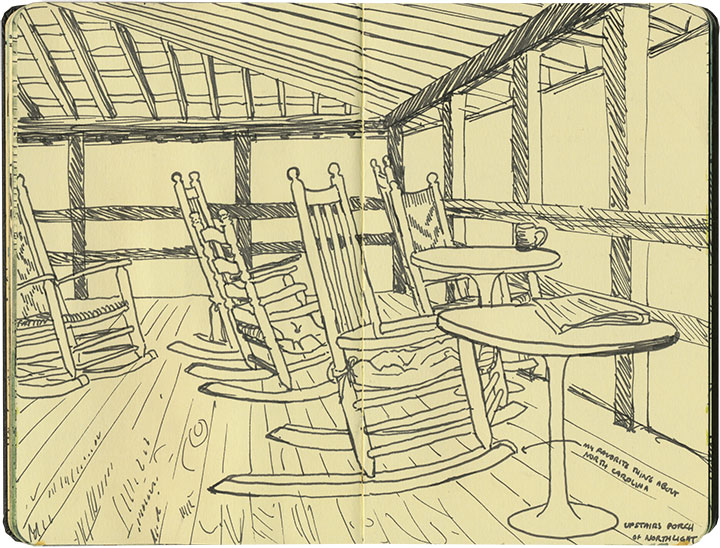
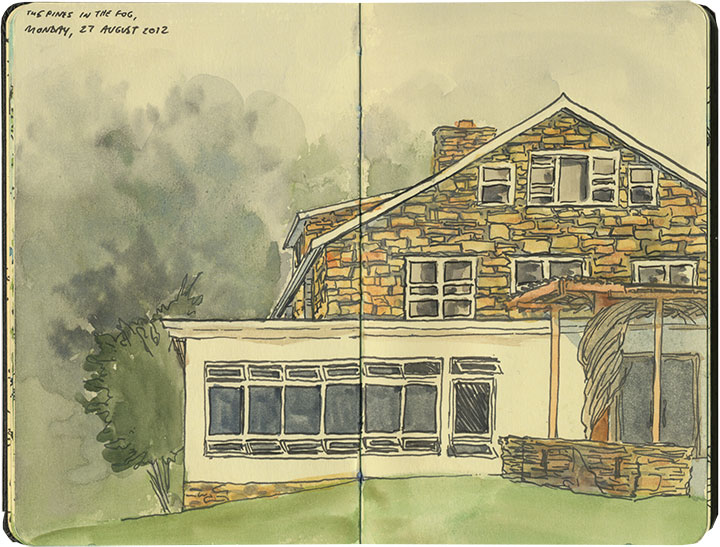
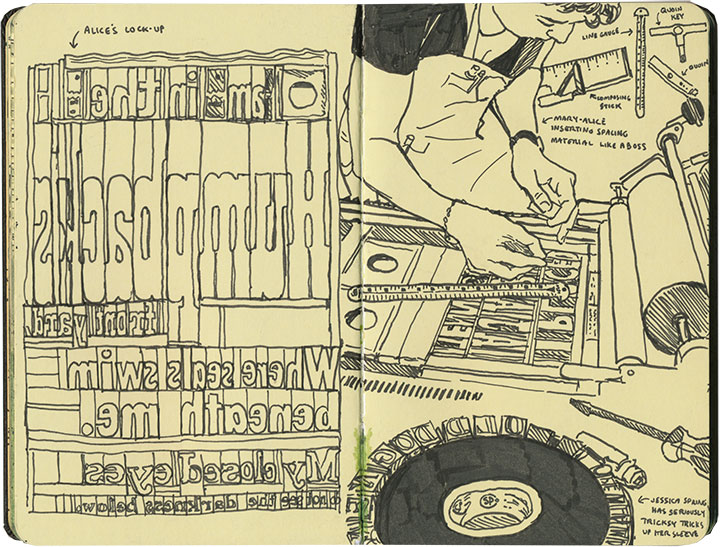
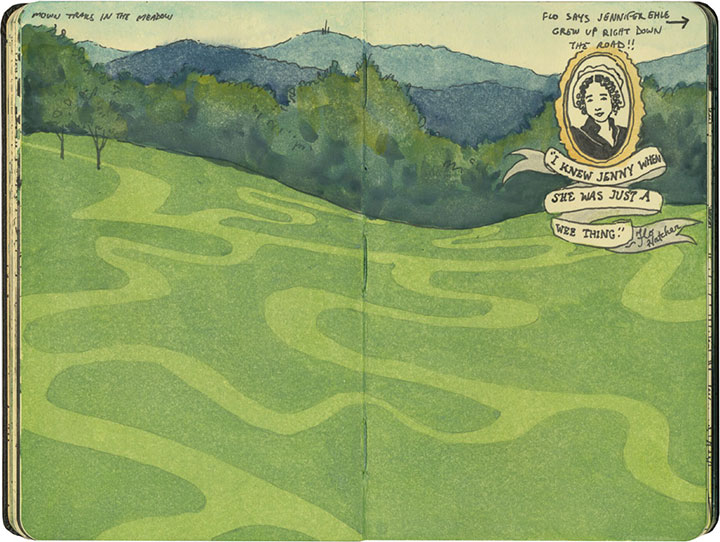
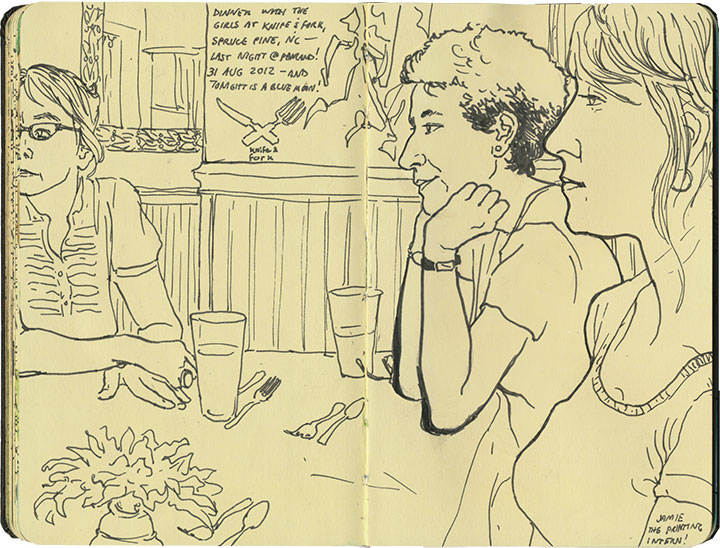
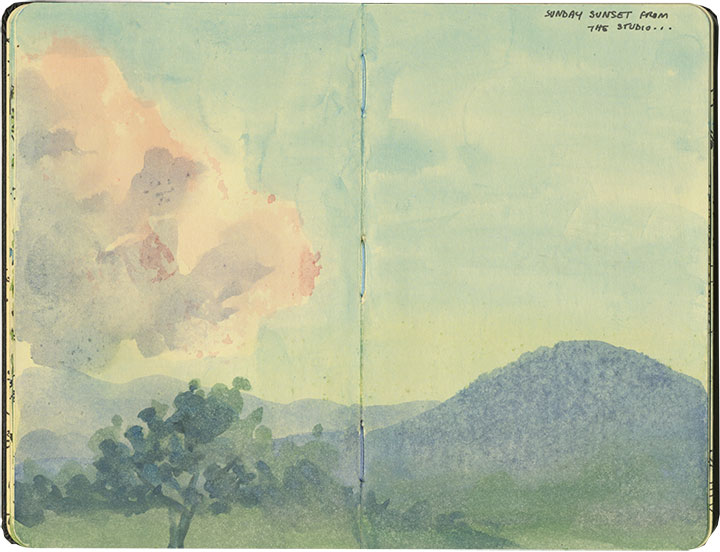
In short: we can’t wait to go back. Huge thanks to the lovely folks at Penland for hosting us and creating such a wonderful place to learn and make things; to our seven fabulous students for their enthusiasm and willingness to dive right in; and to our angelic friend Mary-Alice for being the absolute hands-down best teaching assistant the world has ever seen. Hope to see y’all again soon!

August 29th, 2012
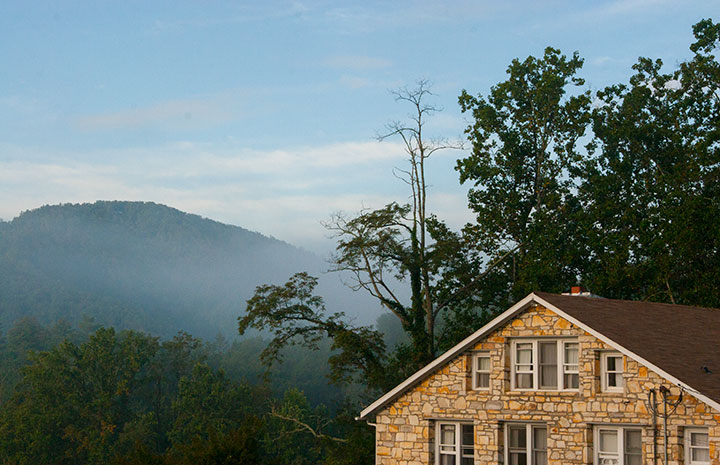
All I can manage is a quick note today—because this is where I am right now … and this place has got me pretty speechless.
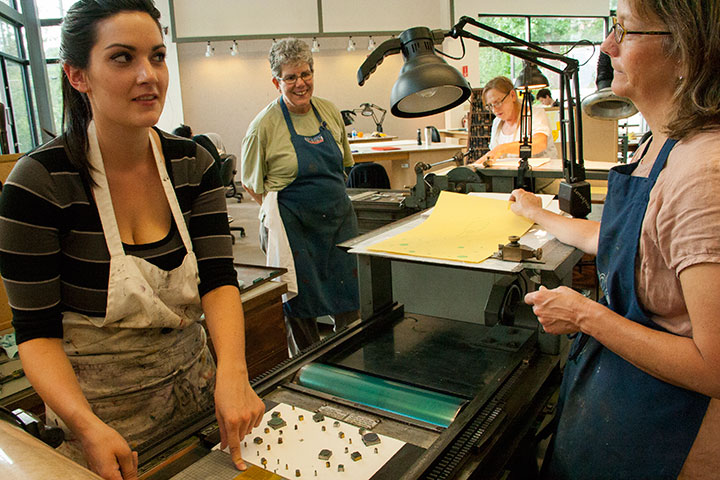
I’m here teaching with Jessica this week, with a studio full of smart, sassy, and seriously talented women.
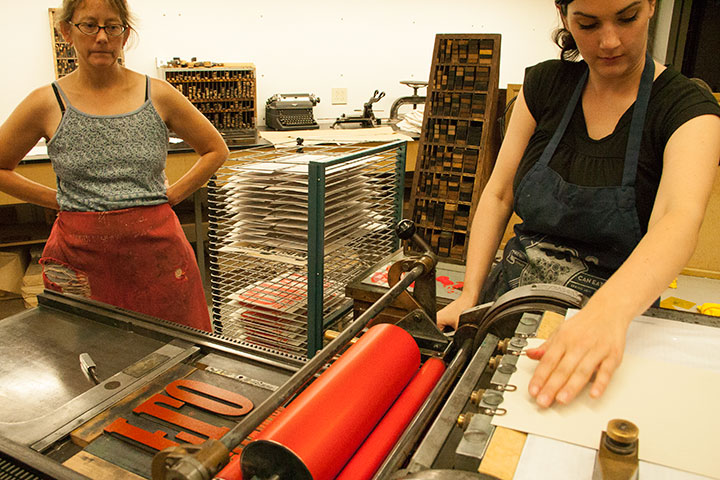
The class has got us inspired to stay up late printing every night, but it’s hard to feel tired—

—when you’ve got this view waiting for you when you return to work every morning.
August 22nd, 2012
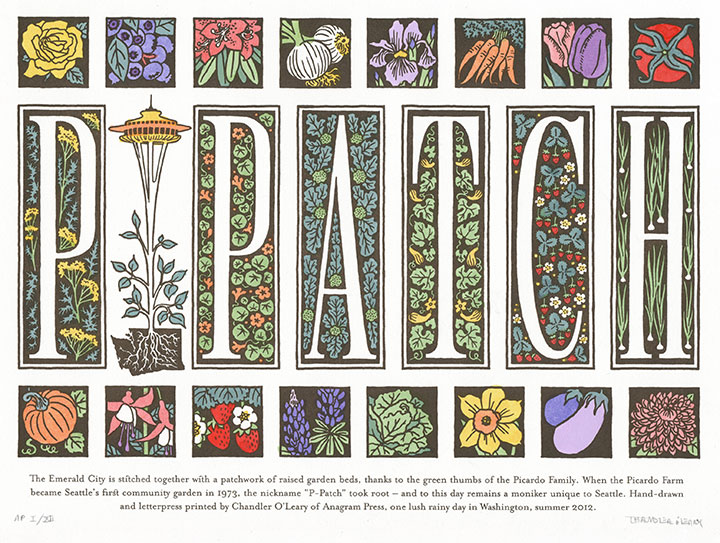
A couple of months ago I was asked to create a letterpress broadside for a collaborative print portfolio for a show in Asheville, put together by the Ladies of Letterpress. The theme was Expanding Communities—beyond that, we could do anything we wanted. So I focused on a unique element of Seattle’s community: the P-Patch.
A P-Patch is a community garden like any other—and completely unlike any other. The name comes from the Picardo family, who converted their farm into the city’s first truly communal garden in the 1970s. So to this day, if you life in Seattle, you tend your p-patch, not your garden plot. That just charmed the heck out of me, and I wanted to create a tribute to it.
P-Patch is completely hand-lettered, as well as hand-painted with watercolor, in homage to the hard work required to maintain a thriving garden. Many thanks to the Ladies of Letterpress gals for inviting me to be a part of the portfolio—I can’t wait to see what everyone else came up with!
July 6th, 2012
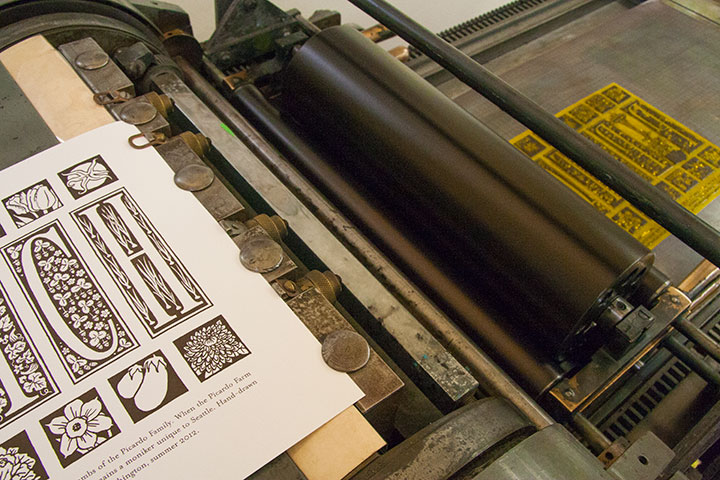
I’m working on a little something in Jessica’s studio right now.
Something that’s making me downright hungry.
I’ll show you the finished product as soon as it’s done—provided I don’t go bury my head in the veggie crisper first!
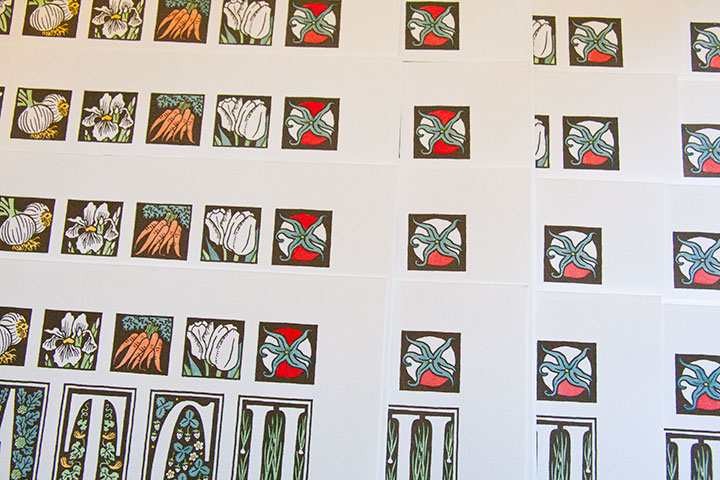
June 13th, 2012
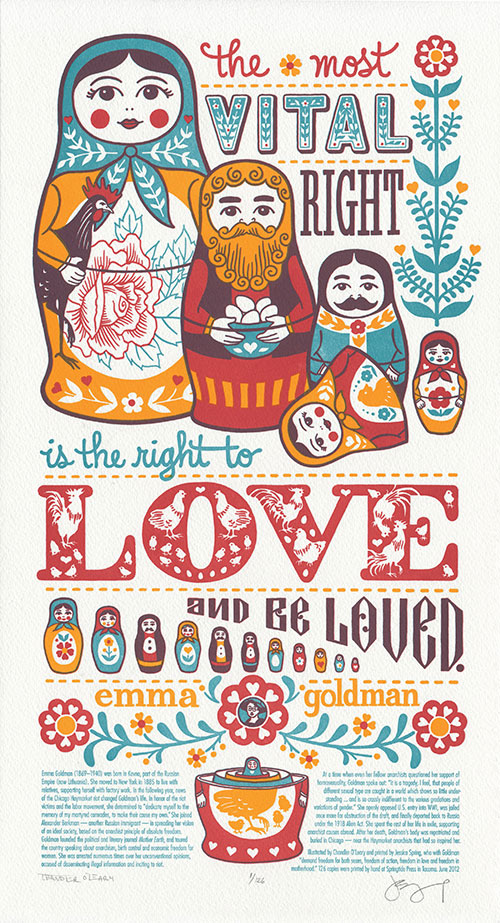
If you happen to live in Washington state, you can’t help but notice that love is in the air. It’s not quite what you think, though—rather than turtledoves and cupids flying around, the breeze is carrying ballot petitions and angry voices.
Though Washington became the seventh U.S. state to legalize same-sex marriage earlier this year, opponents forced a voter referendum to decide the issue this November. So while we’d rather just toast our friends and their families, we’ve got to put up our dukes first.
Already tempers are running high, and everyone seems to be up in arms—it’s total anarchy out there. So we thought, who better to talk to than an anarchist?
The most vital right is the right to love and be loved. —Emma Goldman
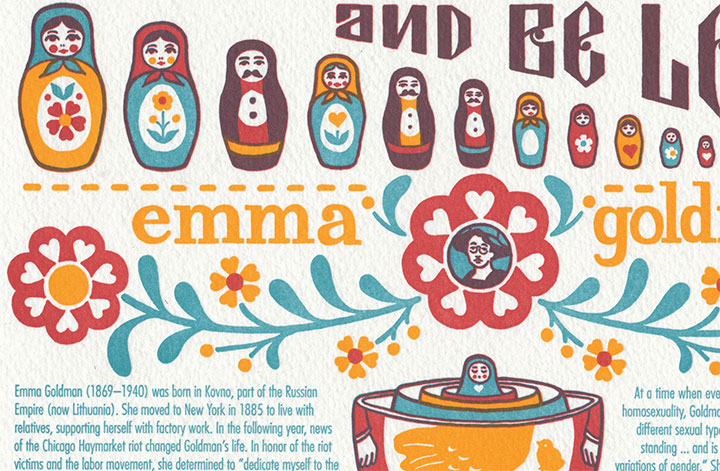
Huh. Pretty down-to-earth for an anarchist, actually. Especially if you consider some of the other things Emma’s said in the past.
I think that if we could somehow put all the ladies we’ve featured previously into a room together, they might end up killing each other (good thing they’re already dead, eh?). They all had such different ideologies and passions that I can’t imagine all fourteen of them agreeing on any one thing. But I’m fairly sure they’d be united over Emma—in thinking she was a complete weirdo, that is. (Sorry, Emma.)
Yet for all her outlandish creeds and fierce opinions, her thoughts on families, love and motherhood cut straight to the heart of the matter. And that’s what drew us to her.
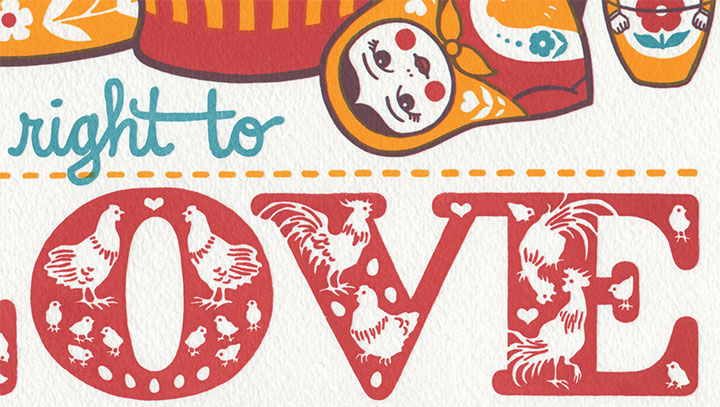
To pay homage to Emma’s folksy words, we turned to folk art for inspiration. (Get out your grandma’s Pyrex and raise a glass!) Love Nest is dominated by a lively brood of nesting matryoshka dolls. Each individual is different, but together they complete the picture of a nurtured, multicolor family. Roosters, hens and chicks complete the flock waiting for the next generation to hatch as Emma’s words stitch the family together.
To support the diversity nested within every family, we’ll be donating a portion of the proceeds to both the Rainbow Center and Oasis Youth Center, right here in T-town. The Rainbow Center is dedicated to eliminating discrimination based on sexual orientation and gender. Oasis is a drop-in support center dedicated to the needs of GLBTQ youth ages 14-24.
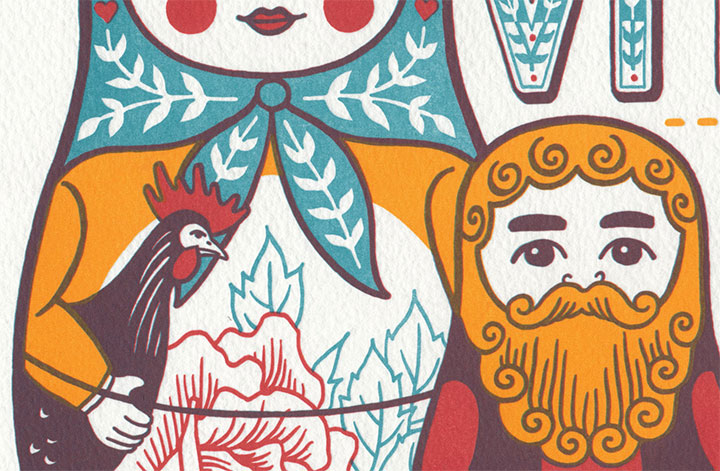
Speaking of chickens, there’s another tribute hiding in here—a nod to the very first matryoshka doll ever made.
This might well be the most difficult piece we’ve tackled yet. Beyond the challenges of marrying (no pun intended) the views of a 19th-century fringe activist to modern-day social issues, we also had some seriously precarious business on the technical side. Those of you who are into the nitty gritty details of letterpress may know that each print color requires a separate plate, a separate pass on press. We’ve got four colors in the final result, but because of the tricky magic of translucent inks, there’s actually only three plates/three passes here. The red and teal mix to make brown—which means that the registration (alignment) of each plate had to match up just right.
I was expecting Jessica to throttle me when I showed her the color separations, but as usual, she barely even batted an eye: “Yeah, we can do that.”
Or maybe she just knows me so well now that she’s expecting the crazy.
• • • • • • • • • • • • • • • • • • • • • • • • • • • • • • • • • • • • • • • • • • • • • • • • • • • • • • • • • • • •
Love Nest: No. 15 in the Dead Feminists series
Edition size: 126
Poster size: 10 x 18 inches
Printed on an antique Vandercook Universal One press, on archival, 100% rag (cotton) paper. Each piece is numbered and signed by both artists.
Colophon reads:
Emma Goldman (1869 – 1940) was born in Kovno, part of the Russian Empire (now Lithuania). She moved to New York in 1885 to live with relatives, supporting herself with factory work. In the following year, news of the Chicago Haymarket riot changed Goldman’s life. In honor of the riot victims and the labor movement, she determined to “dedicate myself to the memory of my martyred comrades, to make their cause my own.” She joined Alexander Berkman—another Russian immigrant—in spreading her vision of an ideal society, based on the anarchist principle of absolute freedom. Goldman founded the political and literary journal “Mother Earth,” and toured the country speaking about anarchism, birth control and economic freedom for women. She was arrested numerous times over her unconventional opinions, accused of disseminating illegal information and inciting to riot.
At a time when even her fellow anarchists questioned her support of homosexuality, Goldman spoke out: “It is a tragedy, I feel, that people of different sexual type are caught in a world which shows so little understanding … and is so crassly indifferent to the various gradations and variations of gender.” She openly opposed U.S. entry into WWI, was jailed once more for obstruction of the draft, and finally deported back to Russia under the 1918 Alien Act. She spent the rest of her life in exile, supporting anarchist causes abroad. After her death, Goldman’s body was repatriated and buried in Chicago—near the Haymarket anarchists that had so inspired her.
Illustrated by Chandler O’Leary and printed by Jessica Spring, who with Goldman “demand freedom for both sexes, freedom of action, freedom in love and freedom in motherhood.”
UPDATE: poster is sold out. Reproduction postcards available in the Dead Feminists shop!

May 25th, 2012
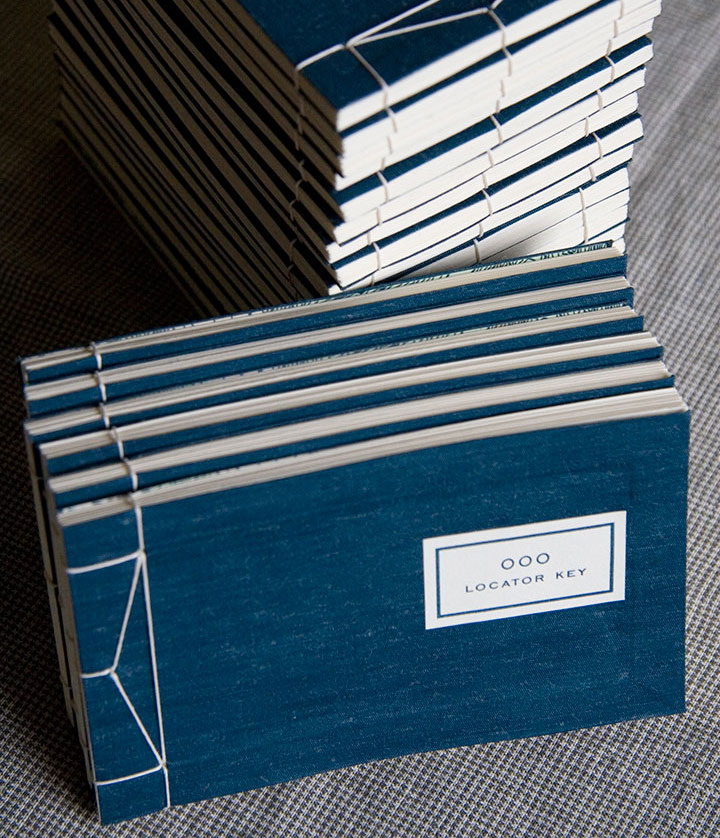
Speaking of keeping busy, looks like I’m not the only one who’s been working on my Local Conditions book. The kind folks at Stanford University put together a little video demonstrating how book works. So now, instead of having to explain it step-by-step, and hope for the best, I can actually show you in real time. Take a gander:
And if you happen to be in the Bay Area, you can see the book for yourself at the San Francisco Center for the Book. From now through August 31, Local Conditions is on display as part of the exhibition Exploding the Codex. The show highlights unusual and unexpected structures by over forty artists—pieces that blow the lid off of the standard definition of what a book can be. I’m sad not to be able to get there myself before the show closes, but if you’re in the area, stop by on June 15 for the opening reception—and tell ’em hello from me.
May 20th, 2012
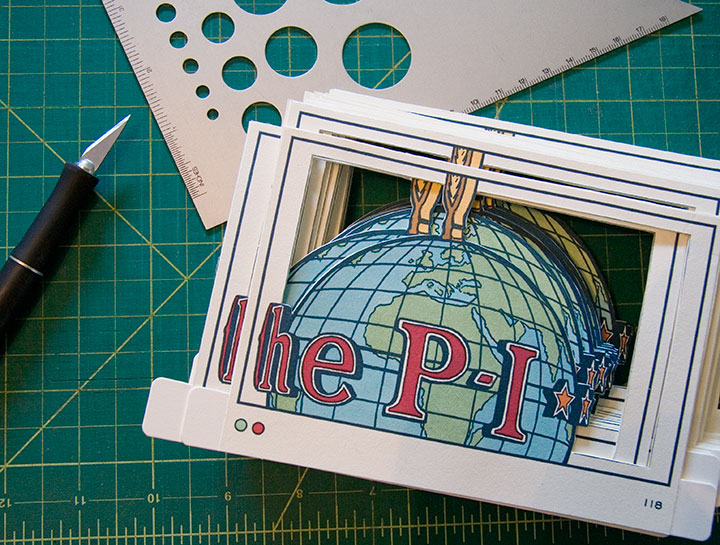
Now that I’m back in town, I’ve got deadlines. Lots of them.
Like, hundreds and hundreds. Each one shaped like a little P-I Globe, a little Space Needle, or any number of things.
You get the idea.
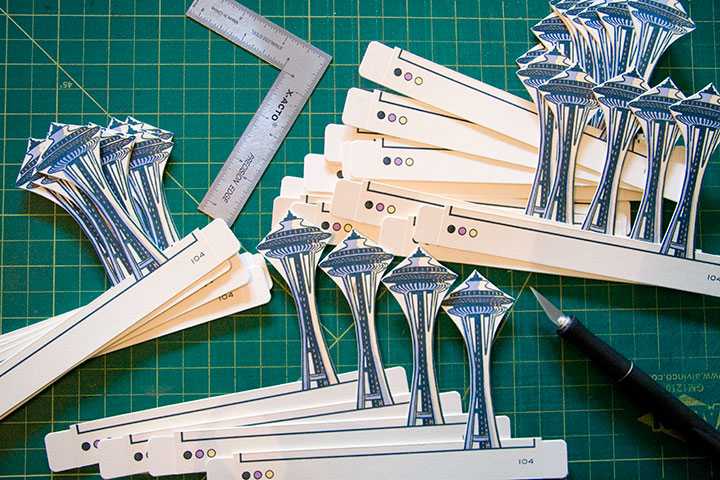

![Chandler O'Leary [logo]](https://chandleroleary.com/wp-content/themes/chandleroleary/images/logo.png)













































